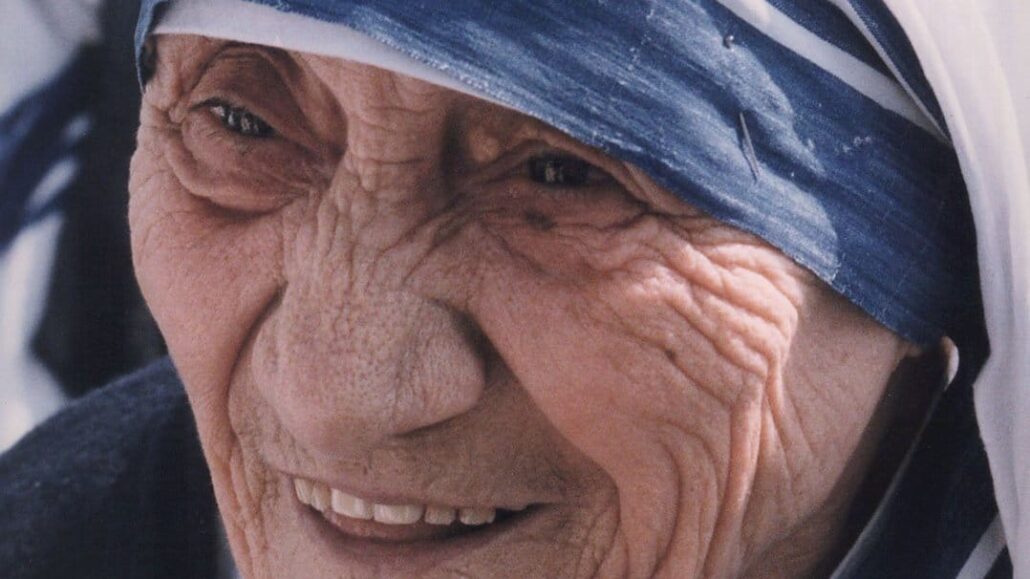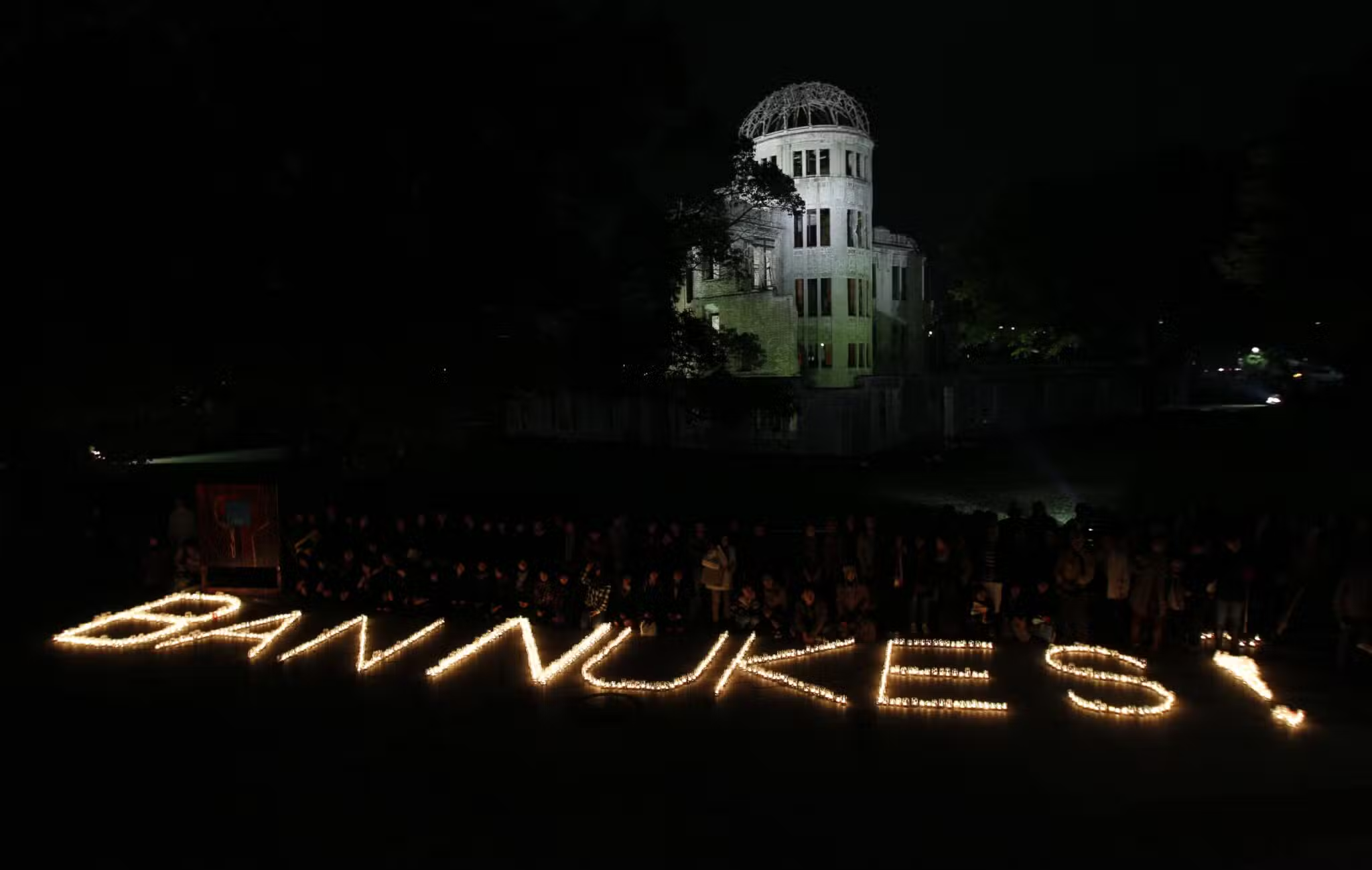Mother Teresa of Calcutta strips you and me of every excuse to do nothing to help the hungry, the sick, the lonely, the unloved, the rejected, the hurting, the confused, the imprisoned.
Over and over again the tiny woman, who will be officially proclaimed a saint on September 4, asks us not to praise her but to join her; to remember that slums, homes for the dying, and prisons are not the only places where mercy, love, and attention are needed. Her canonization will take place one day before the 19th anniversary of her death, in 1997 at age 87.
Look across the dinner table, she instructs. Be alert at work, at school, on the subway, at church. Be aware of what’s around you. Constantly. “God doesn’t ask us to do great things. He asks us to do small things with great love,” she tells us.
Those who knew her well repeatedly state that the core message of the “saint of the gutters” is simple, clear, and melded at high mystical heat to Jesus’ words: “Truly I tell you, whatever you did for one of the least of these . . . you did for me.”
In his homily to the 300,000 people crowding St. Peter’s Square for Mother Teresa’s beatification ceremony, declaring her Blessed in October 2003, St. John Paul II used one of the pending saint’s often-used descriptions of the abandoned and broken—“Jesus himself, hidden under the distressing disguise of the poorest of the poor”—to underscore her conviction “that in touching the broken bodies of the poor she was touching the body of Christ.”
And that is what a 36-year-old Loreto sister who had taken the name Teresa (she was born Gonxha [Agnes] Bojaxhiu in Skopje, Macedonia, on August 27, 1910) made the focus of her life after she underwent “a decisive mystical encounter with Christ” on September 10, 1946, on the way to a retreat.
In that interior locution and others over the following months, the future Mother Teresa, by her own account, was told by Jesus “to give up all and follow him into the slums—to serve him in the poorest of the poor.”
“The voice kept pleading, ‘Come, come; carry me into the holes of the poor. Come, be my light,’” she said. It took two years, but in 1948 Sister Teresa received the official permissions needed to leave the comfort and safety of the Catholic girls high school in Calcutta (now Kolkata), where she had taught geography and history since 1931.
After taking basic nurse training at Patna, India, she boarded a train for the slums of Calcutta and would begin her work. Alone.
A New Direction
“Teresa was not alone for long. Within a year, she found more help than she anticipated. Many seemed to have been waiting for her example to open their own floodgates of charity and compassion,” writes Joan Guntzelman, author of A Retreat with Mother Teresa and Damien of Molokai: Caring for Those Who Suffer (St. Anthony Messenger Press, 1999).
“Young women came to volunteer their services and later became the core of her Missionaries of Charity. Others offered food, clothing, the use of buildings, medical supplies, and money. As support and assistance mushroomed, more and more services became possible to huge numbers of suffering people,”
adds Guntzelman.
Many people are holy. Many are charismatic. Many do good works. A good number incorporate all three. Yet Mother Teresa seems to take it to another level—to apostolically inspire others deeply, quickly, and often for the long term.
“Yes, she had a remarkable effect on people, even after a single meeting or even a glance at her,” said Missionaries of Charity Father Brian Kolodiejchuk, who is the postulator—primary advocate—of Mother Teresa’s sainthood cause, as well as the superior general of the Missionaries of Charity Fathers.
“I heard once that a man came back to the practice of his faith by just seeing her, not even actually meeting her,” Father Brian told St. Anthony Messenger from Rome. “I think the presence of God she radiated and the power of her example had this extraordinary effect,” the priest continued.
It probably did not hurt that the former high school teacher was fluent in five languages—English, Albanian, Serbo-Croatian, Hindi, and Bengali—and could understand some Italian and Spanish.
“Her words and messages were quite simple, yet it seems that her voice had some kind of anointing. I remember even before I met her, I listened to a tape of her speaking at the Eucharistic Congress in Philadelphia in 1976 and was especially moved to tears by her praying the prayer of Cardinal [John Henry] Newman on radiating Christ.
“She was able to give hope to people in seemingly hopeless situations. She was like a catalyst to many good endeavors. People saw her work and wanted to contribute, to participate, or even to do the same in their own places,” says Father Brian.
An emphatic “amen” to that would come from Donna-Marie Cooper O’Boyle, who has written and spoken widely about her lengthy friendship with Mother Teresa, and who has written three books about the saint of Calcutta.
“Mother Teresa could connect with others easily because she never judged a person. She only loved and served, seeing Jesus in everyone,” says the popular author and well-known EWTN radio and television personality. “Mother Teresa did not have her head up in some lofty cloud contemplating heavenly bliss. Her worn-out sandals were planted firmly on the ground,” Cooper O’Boyle tells St. Anthony Messenger. “She was well aware of today’s state of affairs and did not mince words when opportunities arose to speak out against the sins of abortion and euthanasia—always in protection of human life.”
One such occasion was her acceptance speech when awarded the Nobel Peace Prize in December 1979: “I feel the greatest destroyer of peace today is abortion. . . . If a mother can kill her own child, what is left for me but to kill you and you to kill me?”
“Most of the time, though,” says Cooper O’Boyle, “Mother Teresa’s speaking out was accomplished quietly, and, I dare say, almost secretly, as she ministered to each need as it unfolded before her. She taught that the poor are not only those who are starving for a piece of bread, but the poor might be someone in your own family who is starving for love. She remained small and let God do the work. Each person she ministered to was ‘Jesus in the distressing disguise of the poorest of the poor.’”
One of the nearly two dozen letters that Mother Teresa wrote over a decade to Cooper O’Boyle urged the mother of five to apply that often- employed image to her former husband, with whom she was having brutal child-custody battles. Cooper O’Boyle says she asks Mother Teresa for her intercession “several times a day” and credits her “spiritual mother” for helping her break down unneeded walls between her public persona and personal life.

“As years unfolded and my ministry grew, I was often face-to-face with so many wounded people, all starving for love and understanding,” says Cooper O’Boyle. She talks of one time in particular, one that she writes about in the preface of her memoir, The Kiss of Jesus: How Mother Teresa and the Saints Helped Me to Discover the Beauty of the Cross.
She remembers when a young single mother was sharing her story: “I decided, on the spot, to let her know that I had been a single mom to five children and that God had gotten me through all of the trials and tribulations that came with the territory. She was shocked to hear that I, an EWTN TV host, had been a single mother.”Cooper O’Boyle could clearly see that the woman had gained hope from her own example of success. “I knew then that it was so important to share our own personal struggles to help others. In a way, I think that when others know that someone can truly understand their plight, they can more easily relate to God’s message of love and mercy.”
And Mother Teresa?
She was hesitant, at first, to share her story. “As time went on, Mother Teresa allowed some media coverage when she realized that the attention could raise an awareness of the poor all over the world and the poor right in our midst,” Cooper O’Boyle observes. Still, Mother Teresa “strove to remain hidden as much as possible” and “did not want any attention given to herself, but instead wanted all glory going to God.”
Another firsthand example: Father Brian tells a story from “a superior of our community in Calcutta during Mother Teresa’s last years,” which “provides a window into her sense of humor.”
His confrere told him: “Media exposure was a great penance to her. She only put up with it to make the message and the work known. She joked amongst us that for each photo taken, Jesus had to release one soul from purgatory. With her constant sense of humor she was able to joke in the last year of her life that now Jesus had to release two souls from purgatory instead of just one, for each photo taken. Her reason was that prices were going up everywhere. ‘Inflation!’ she’d say. Since everything else had become more expensive, a photo should certainly cost two souls now!
“She was such a public person who still managed to keep her personal life private during her lifetime,” Father Kolodiejchuk says. “Her ordinariness on the outside hid so much of her holiness inside. Now in heaven, her perspective is different. Now so many details about her interior life and her actions are revealed for the benefit of others.”
Surrender Your Heart
The priest is alluding to the jarring posthumous revelations about Mother Teresa’s searing lack of divine consolation for nearly 50 years following the founding of the Missionaries of Charity. “This is an aspect of Mother Teresa’s life that warrants a full explanation not possible in the confines of an interview,” the postulator tells St. Anthony Messenger. “But briefly, I could say that her darkness was more a trial of faith and especially of love, but not a real doubt in the sense of actually doubting God’s existence or presence or call.
“She was so united to Jesus by pure, naked faith that she paradoxically lived that union by not experiencing it. Just as Jesus was always united to his Father, but did not experience it in the Garden [of Gethsemane] or on the cross, so Mother Teresa knew she was united in mind and soul to Jesus, even when she experienced the opposite.”
Cooper O’Boyle says that “finding out about Mother Teresa’s dark night of the soul only reaffirmed for me the deeply profound holy life that she lived, and the certainty that she was specially chosen by God to live out these particular trials. Jesus allowed her to experience some of the things he endured—suffering, abandonment, and more.
“She teaches us to fully surrender our hearts to God. We cannot rely on our feelings.”
Decades ago Mother Teresa confided as much in a note to Jesuit Father Joseph Neuner, an adviser to her and a well-known theologian, influential at Vatican II: “I accept not in my feelings—but with my will, the will of God—I accept his will.”
For God’s Glory
Because Pope John Paul II waived the five-year waiting period required for the initiation of a sainthood cause, Mother Teresa’s campaign was launched in 1999. Father Brian was named postulator, the person overseeing the cause to completion.
“From the testimonies and the documents, we were able to put the mosaic of her life together and see, as we were not able to while she was alive, the profundity of her holiness,” he says.
“Certainly a most surprising” aspect of the work for him, he goes on, was verification of the private vow Sister Teresa took with permission of her confessor in 1942—a “vow to refuse Jesus nothing.”
“The biggest surprise of them all was the spiritual darkness” unveiled in her letters, the priest says, adding: “I think that until these ‘secrets’ were discovered, most people admired Mother Teresa as a holy woman known for her charitable activity toward the poorest of the poor throughout the world. But then, we were able to recognize the depth of her holiness and that, in fact, Mother Teresa is one of the great mystics of the Church.”
What might Mother Teresa have said about being named a saint? “It is ‘normal for a religious to be a saint,’ she used to say to the sisters,” Father Brian answers. “So being holy is what she would have expected. On the other hand, about being proclaimed a saint, she would probably say what she said about all her awards and recognitions—‘let it be for the glory to God and the good of the people, especially the poor.’”
That humble approach will, no doubt, be on this priest’s mind as he presents Mother Teresa to Pope Francis for canonization: “When she would be asked point-blank if she was aware of being called a ‘living saint,’ she would say all the time, ‘Holiness is not a luxury of the few, but a simple duty for me and for you.’”







